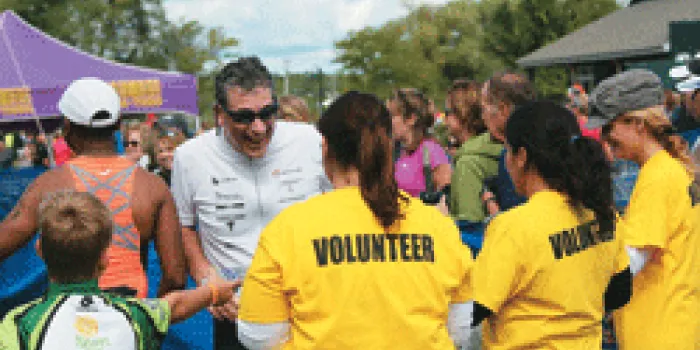A horde of fit athletes will gather September 7–8 on the banks of Canandaigua Lake in upstate New York to swim, bike and run in a challenging sporting event. The Finger Lakes Triathlon is the biggest annual fundraising event for the Mary M. Gooley Hemophilia Center in Rochester, New York.
The center held its first triathlon in 2001. Bob Fox, the center’s president/CEO, recalls that a former board member, who was a triathlete, came up with the idea. “At the time, multi-sport events were one of the most rapidly growing sporting events in the world,” says Fox. The 2001 triathlon drew approximately 200 participants and turned a small profit for the center. Twelve years later, the event is more than six times as large and pulls in a nice profit.
A triathlon has three components: swimming, biking and running. Distances can vary. An Olympic triathlon has a 1.5-kilometer swim (0.93-mile), a 40K (25-mile) bike ride and a 10K (6.2-mile) run. A sprint triathlon comprises a 750-meter (0.47-mile) swim, a 20K (12-mile) bike ride and 5K (3.1-mile) run. Iron Man triathlons are much longer—typically a 2.5-mile swim, 120-mile bike ride and a 26.2-mile marathon.
The Finger Lakes Triathlon offers six races: two kid’s triathlons, two individual races in Olympic and sprint distances, and two relay triathlons, in which teams can participate in the sprint and Olympic distances.
The event grew so large that the center could no longer run it, so it hired a race management company called Score This!!! to manage the logistics of the race. It pays the company a flat fee and receives all the funds from registration fees, participant fundraising and corporate sponsorships. Tom Wilmarth, vice president of public policy at the center, is also the triathlon director. “It’s a significant undertaking that requires attention virtually year-round,” says Wilmarth.
Unlike many other chapter fundraisers, most participants, sponsors and spectators have little or no connection to the bleeding disorders community. For instance, the lead sponsor of the race is Wegmans, a privately owned supermarket chain based in Rochester. “About 250 Wegmans employees participate in the race,” Wilmarth says. Other sponsors include local sporting goods stores, food manufacturers and distributors, restaurants, bicycle shops and the center’s business partners, including Rochester General Hospital.
Despite its popularity with the wider community, the Finger Lakes Triathlon is strongly branded as a fundraiser for the center. Anyone who interacts with the event learns about bleeding disorders. “The triathlon provides a ‘soapbox’ from which we talk to our patients and to the wider community about the benefits of healthy lifestyles,” says Fox.
The center uses a peer-to-peer fundraising program that it calls “Train for Treatment”(TFT), which encourages athletes and others to raise money online. Each TFT participant has a Web page with information about the center and bleeding disorders. Athletes can also join the “Tri-Buddy” program to be paired with a child patient from the treatment center and have the opportunity to meet each other. The participant’s Web pages include the child’s story and information on how the center helps manage his or her bleeding disorder. In 2012, the TFT program alone raised approximately $50,000. Peter A. Kouides, MD, was an early supporter of the Tri-Buddy program. He is the center’s medical director and director of research, and he is an avid cyclist and triathlete himself.
To include more children in the triathlon, the center plans to add a new element this summer and fall: partnering with CSL Behring’s “Getting in the Game” program. If all goes well, three adult athletes with bleeding disorders will offer a training program for kids in August, each focusing on swimming, biking and running, respectively. Part of the program includes registration for the triathlon in September. The athletes will instruct the children on how to safely train for the triathlon, with specific attention paid to managing their bleeding disorders.
“With preparation, common sense and working with their HTC, kids with bleeding disorders can join in many sports, just like anybody else,” says Kouides. In 2012, the triathlon had approximately 1,300 participants, including about 300 children, says Fox. The event has raised more than $200,000 annually for several years. “It’s been a great event for the center,” Fox says.
The center plans to continue to increase the number of participants and sponsors, and share information on bleeding disorders in the local community. “With a triathlon, there are endless possibilities for participation, partnership and promotion,” Fox says.

